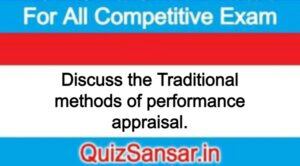
Discuss the Traditional methods of performance appraisal.
Discuss the Traditional methods of performance appraisal.
Or
Explain the different methods of performance appraisal.
Or
Describe the forced choice method of performance appraisal.
Ans.
Traditional Methods of Performance Appraisal
There are following methods in practice for performance appraisal :
1. Ranking Method: It is a very easy process in which an employee’s work is compared with others and then categorised. This method is used where manpower is not in large scales. The basis of this method is relative evaluation of employees.
2. Paired Comparison Method: It is a transformed method of ranking method. In this method workers are compared in pairs and then categorised. It means an employee is compared to others in a group at a time.
Example: There are three employees in an organization named A, B and C have to be evaluated. So first A is compared to B and then B to C and the C is compared to A. Thus there will be three pairs of comparison of each employee. Number of pairs can be calculated by following formula:
No. of pair = N-1/2
Where N = Total No. of employees.
3. Rating Scale Method: In this method some specific merits of an employee are selected by management and then compared with others. In other words a list of merits and characteristics of employees is prepared by an officer and then evaluated. In this method officer marked that parameter for every employee which he assumed right. Five parameters have marked for calculation of actual performance appraisal.
4. Graphical (Continuous) Scale Method: This method is like the method of rating. The only difference that the characteristics on which employees are evaluated shown by graph parameter of merit may be quantitative or descriptive. Hence different categories of any quality can be explained by best average, below and above average and worst or in number in 5, 4, 3, 2, 1.
5. Check List Method: In this method of evaluation a list contains performance and behaviour related details of employees. An officer deputed for evaluation checks the details and informed to management whether that facts applicable on employee or not or there is any doubt. Marks allotted to particulars on the basis of their importance. The average calculation of these details is the final rating of employee checked by evaluating officer.
6. Forced Choice Method: In this method a rating form used by management to evaluate the performance appraisal of employees, consists details about employee. These particulars are grouped in two or three or four groups. Every group may contain only positive or negative details. An officer evaluates only one characteristic in every group which is the best character or merit of employee (in case of positive group) and applicable least on employee (in case of negative group). After evaluating all the details, the average calculation will be final rating of employee.
Some raters suffer from a constant error They do not evaluate the employees properly. This system minimises rater’s bias so that all employees are not similarly rated. The main idea in this system is to spread rating in a number of grades. Forced distribution of rankings is feasible for a large group of employees.
7. Critical Incident Method: In this method reactions of employee on main incidents in organization, whether it is positive or negative in nature, evaluated by management. Observers take many data and allotted marks according to behaviour of employee at the time of every incident. The average of this working becomes the final rating of employee.
- What is meant by Database Management System?
- Discuss the advantages and drawbacks of database.
- What do you mean by database ? Discuss its Characteristics.
- What is Data Mining?
- What are the conditions of communication?
- What do you mean by business communication ?
- organization / Differentiate between classical and modern theory of organization
- What is forecasting






